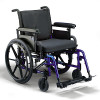Invacare PATRIOT Owners Manual - Page 17
Transferring To And From Other Seats, Percentage Of Weight Distribution
 |
View all Invacare PATRIOT manuals
Add to My Manuals
Save this manual to your list of manuals |
Page 17 highlights
SECTION 2-SAFETY/HANDLING OF WHEELCHAIRS TRANSFERRING TO AND FROM OTHER SEATS ƽ WARNING BEFORE attempting to transfer in or out of the wheelchair, every precaution should be taken to reduce the gap distance. Align both casters parallel with the object you are transferring onto. Also be certain the wheel locks are engaged to help prevent the wheels from moving. CAUTION When transferring, position yourself as far back as possible in the seat. This will prevent damaged upholstery and the possibility of the wheelchair tipping forward. NOTE: For this procedure, refer to FIGURE 2.3. NOTE: This activity may be performed independently provided you have adequate mobility and upper body strength. 1. Position the wheelchair as close as possible along side the seat to which you are transferring, with the front casters parallel to it. 2. Engage wheel locks. 3. Remove or flip back armrests. 4. Shift body weight into seat with transfer. MAXIMUM GAP DISTANCE FIGURE 2.3 - TRANSFERRING TO AND FROM OTHER SEATS NOTE: During independent transfer, little or no seat platform will be beneath you. Use a transfer board if at all possible. PERCENTAGE OF WEIGHT DISTRIBUTION ƽ WARNING DO NOT attempt to reach objects if you have to move forward in the seat or pick them up from the floor by reaching down between your knees. The seat depth, back height/angle, seat angle, size/position of the front casters, seatto-floor angle, position of the rear wheels, correct anti-tipper as well as the end user's disability or end user's physical condition and capabilities directly relate to the stability of the wheelchair. Any change to one or any combination of the nine may cause the wheelchair to decrease in stability. These adjustments MUST be performed by a qualified technician. NOTE: For this procedure, refer to FIGURE 2.4. Part No 1088909 17 Patriot™
-
 1
1 -
 2
2 -
 3
3 -
 4
4 -
 5
5 -
 6
6 -
 7
7 -
 8
8 -
 9
9 -
 10
10 -
 11
11 -
 12
12 -
 13
13 -
 14
14 -
 15
15 -
 16
16 -
 17
17 -
 18
18 -
 19
19 -
 20
20 -
 21
21 -
 22
22 -
 23
23 -
 24
24 -
 25
25 -
 26
26 -
 27
27 -
 28
28 -
 29
29 -
 30
30 -
 31
31 -
 32
32 -
 33
33 -
 34
34 -
 35
35 -
 36
36 -
 37
37 -
 38
38 -
 39
39 -
 40
40 -
 41
41 -
 42
42 -
 43
43 -
 44
44 -
 45
45 -
 46
46 -
 47
47 -
 48
48 -
 49
49 -
 50
50 -
 51
51 -
 52
52 -
 53
53 -
 54
54 -
 55
55 -
 56
56 -
 57
57 -
 58
58 -
 59
59 -
 60
60 -
 61
61 -
 62
62 -
 63
63 -
 64
64 -
 65
65 -
 66
66 -
 67
67 -
 68
68 -
 69
69 -
 70
70 -
 71
71 -
 72
72 -
 73
73 -
 74
74 -
 75
75 -
 76
76 -
 77
77 -
 78
78 -
 79
79 -
 80
80 -
 81
81 -
 82
82 -
 83
83 -
 84
84 -
 85
85 -
 86
86 -
 87
87 -
 88
88 -
 89
89 -
 90
90 -
 91
91 -
 92
92 -
 93
93 -
 94
94 -
 95
95 -
 96
96 -
 97
97 -
 98
98 -
 99
99 -
 100
100 -
 101
101 -
 102
102 -
 103
103 -
 104
104 -
 105
105 -
 106
106 -
 107
107 -
 108
108
 |
 |

